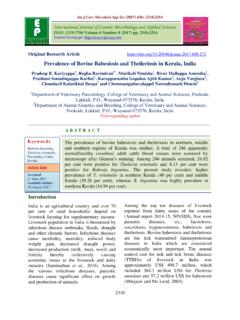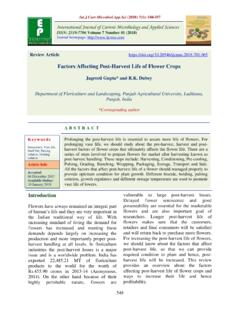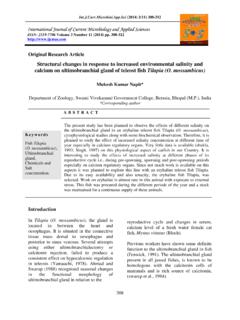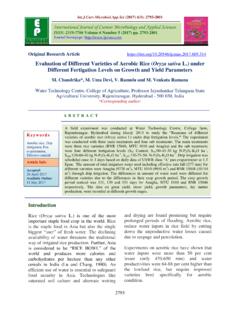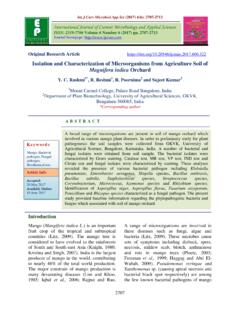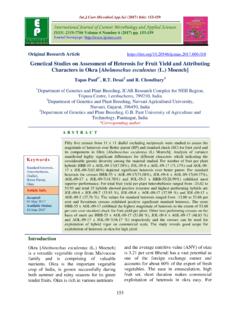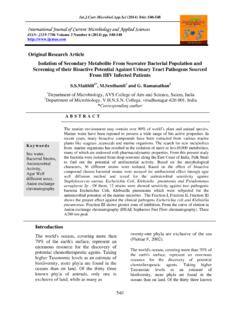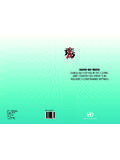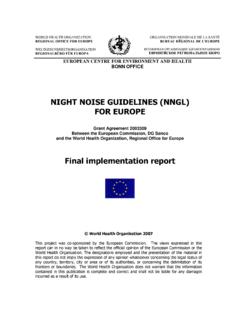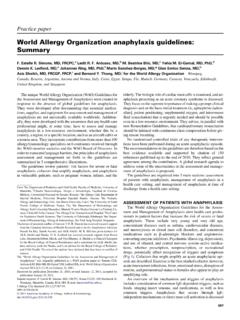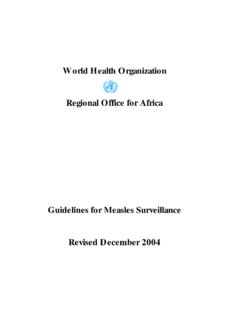Transcription of the guidelines of the World Health Organization …
1 (2017) 6(1): 691-696 691 Original Research Article Prevalence of HIV Infection among Pregnant Women in a Tertiary Care Hospital Akola, India Poonam C. Sayare*, Nitin A. Ambhore, Rupali S. Mantri and Rajesh P. Karyakarte Department of Microbiology, Government Medical College, Akola-444005, Maharashtra, India *Corresponding author A B S T R A C T Introduction AIDS (Acquired Immunodeficiency Syndrome) caused by Human Immunodeficiency Virus (HIV) is a major threat to the global Health and development.
2 The consequences of the disease are undeniable. WHO ( World Health Organization ) stated that global HIV prevalence rate was approximately 35 million in 2013 which constitutes around million HIV infected children less than 15 years of age (Praveena et al., 2016). According to NACO, it is estimated that about 30,000 infants acquire infection each year. Mother to child transmission is by far the most significant route of transmission of HIV infection in children below the age of 15 years (NACO, 2006).
3 The transmission may occur late in pregnancy, during labour, delivery and through breast milk. It is estimated that there are between 22,000 and 61,000 pregnant women living with HIV in India. Out of 27 million pregnancies every year, nearly 49,000 are HIV positive pregnancies (WHO, 2011). Maternal to fetal HIV transmission rate varies from 20 to 25% in absence of any interventions. HIV infected infants and International Journal of Current Microbiology and Applied Sciences ISSN: 2319-7706 Volume 6 Number 1 (2017) pp.
4 691-696 Journal homepage: K e y w o r d s HIV infection, Prevalence of HIV Infection, Pregnant Women. Accepted: 29 December 2016 Available Online: 10 January 2017 Article Info HIV infection in women occurs primarily during their reproductive years, pregnancy provides a opportunity for implementing HIV infection prevention strategies in women. Estimating the rate and trends of HIV seroprevalence among pregnant women provides essential information and monitors its spread within different parts of the country.
5 This study was carried out to estimate the prevalence of HIV infection among pregnant women in tertiary care hospital at Akola. Retrospective hospital record based descriptive study, carried out in Department of Microbiology at Government Medical College, Akola from 2010 to December antibodies were tested by the three rapid tests protocol as per the guidelines of the World Health Organization and the NACO. 8115 women were ready for counseling and HIV testing under ICTC. Overall, HIV-1 antibodies were detected in 36 out of 8115 of the subject, thus HIV prevalence rate was pregnant female was found seroreactive for HIV-2 antibodies.
6 Majority of the HIV positive pregnant women ( ) were in the age group of 25 29 years. Out of 36 HIV positive women, HIV positive women were primigravida and were multigravida. ICTC can provide comprehensive, family centered clinical and supportive services. Thus by estimating seroprevalnce in pregnancy the effective and timely intervention can be undertaken. (2017) 6(1): 691-696 692 children progress rapidly to AIDS. This transmission of HIV from mother to child can be prevented by appropriate measures (ICMR, 2006).
7 As HIV infections in women occur primarily during their reproductive years, pregnancy provides a unique opportunity for implementing HIV infection prevention strategies in women. The incidence of HIV infections, especially in sexually active young people is the most sensitive marker to track the course of HIV epidemic. It is easy to measure the prevalence in this group by tracking the infection rate among the women during their pregnancies. Accordingly, HIV data from antenatal women has been used to monitor trends in the general population and to predict the seroprevalence in young children (Zaba et al.)
8 , 2006; Boerma et al., 2003). Prevention of parent to child transmission of HIV (PPTCT) program has been launched under the NACP in year 2002 (Ashtagi et al., 2011; Sarkate et al., 2015). HIV sentinel surveillance (HSS), data from the pregnant women at antenatal clinics shows considerable difference continue to exist in the prevalence rates across different geographical region of India. Hence, this study was planned to determine the prevalence of HIV infection in pregnant women of a Tertiary Care Hospital, Akola India.
9 Materials and Methods Retrospective hospital record based descriptive study; cross-sectional in design; carried out through the analysis of secondary data collected from ICTC centre; Department of Microbiology at Government Medical College, Akola. The study included all the pregnant women of ICTC from January 2010 to December 2015. Pregnant women registered at the antenatal clinics of this hospital are routinely advised to undergo HIV screening after pre-test counseling and informed consent. All the essential information was collected from the pregnant women by interviewing them.
10 The variables studied included age, marital status, occupation etc. Following the guidelines of NACO, the counselor of the ICTC interviewed the pregnant women under strict confidentiality. After pre-test counseling and obtaining consent from them, blood samples were collected. HIV antibodies were tested by the three rapid tests protocol as per the guidelines laid down by the World Health Organization (WHO testing strategy III) and the testing policy of NACO, Government of India (NACO, 2007).

